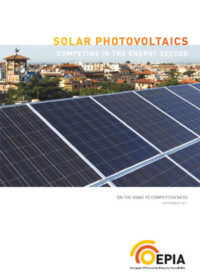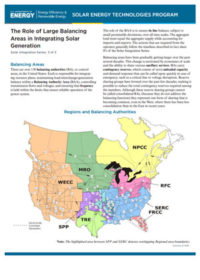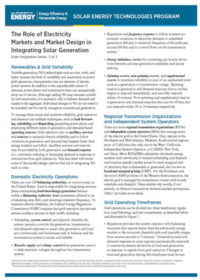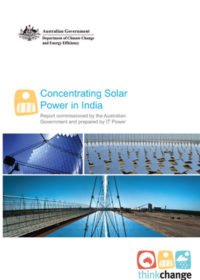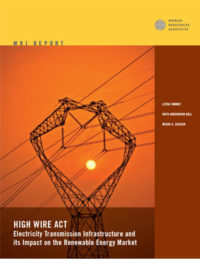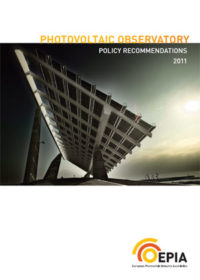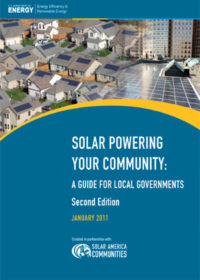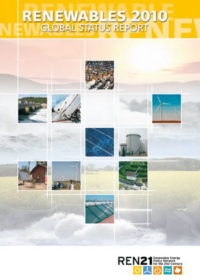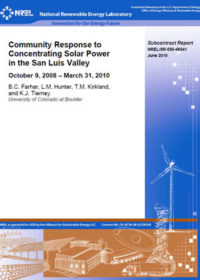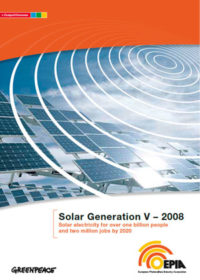Resources
Publications
Our publications, reports and research library hosts over 500 specialist reports and research papers on all topics associated with CCS.
View our Publication Library Disclaimer.
Filter by
Solar photovoltaics: competing in the energy sector
1st September 2011
Topic(s): Economics, Solar energy, Solar photovoltaics
This study considers the full cost of photovoltaic electricity generation by using the concept of Levelised Cost of Electricity (LCOE). This concept takes into account all investment and operational costs over the system lifetime, including fuel consumption and equipment replacement. It thus allows a comparison of the cost of producing a kWh of electricity between various generation technologies such as for example PV and a gas-fired power plant – provided all external cost components are also included. To calculate the LCOE, the investment costs, different lifetimes and risk profiles of systems are taken into account, as are the locations of PV systems and their exposure to annual solar irradiance.
Disclaimer
The content within the Global CCS Institute Publications, Reports and Research Library is provided for information purposes only. We make every effort and take reasonable care to keep the content of this section up-to-date and error-free. However, we make no claim as to its accuracy, currency or reliability.
Content and material featured within this section of our website includes reports and research published by third parties. The content and material may include opinions and recommendations of third parties that do not reflect those held by the Global CCS Institute.
The role of large balancing areas in integrated solar generation
1st May 2011
Topic(s): Renewables, Solar energy
There are over 130 balancing authorities (BA), or control areas, in the United States. Each is responsible for integrating resource plans, maintaining load-interchange-generation balance within a balancing authority area (BAA), controlling transmission flows and voltages, and ensuring that frequency is held within the limits that ensure reliable operation of the power system. This fact sheet dicusses the role these balancing areas have in integrating solar generation.
Disclaimer
The content within the Global CCS Institute Publications, Reports and Research Library is provided for information purposes only. We make every effort and take reasonable care to keep the content of this section up-to-date and error-free. However, we make no claim as to its accuracy, currency or reliability.
Content and material featured within this section of our website includes reports and research published by third parties. The content and material may include opinions and recommendations of third parties that do not reflect those held by the Global CCS Institute.
The role of electricity markets and market design in integrating solar generation
1st May 2011
Topic(s): Renewables, Solar energy
Variable generation (VG) technologies such as solar, wind, and hydro increase the level of variability and uncertainty in power grid operations; characteristics that are inherent of electric power systems. In addition to the unpredictable nature of demand, power plants and transmission lines can unexpectedly drop out of service. This fact sheet will review some of the market design options that aid in integrating VG such as solar.
Disclaimer
The content within the Global CCS Institute Publications, Reports and Research Library is provided for information purposes only. We make every effort and take reasonable care to keep the content of this section up-to-date and error-free. However, we make no claim as to its accuracy, currency or reliability.
Content and material featured within this section of our website includes reports and research published by third parties. The content and material may include opinions and recommendations of third parties that do not reflect those held by the Global CCS Institute.
This report was commissioned by the Australian Government’s Department of Climate Change and Energy Efficiency (DCCEE), with the cooperation of the Government of India’s Ministry for New and Renewable Energy (MNRE).
This report analyses the context, barriers and policy options for the growth of the concentrating solar power (CSP) industry in India, for use by government policy and program implementation staff in both countries. It may also be of interest to others such as CSP developers and investors.
Disclaimer
The content within the Global CCS Institute Publications, Reports and Research Library is provided for information purposes only. We make every effort and take reasonable care to keep the content of this section up-to-date and error-free. However, we make no claim as to its accuracy, currency or reliability.
Content and material featured within this section of our website includes reports and research published by third parties. The content and material may include opinions and recommendations of third parties that do not reflect those held by the Global CCS Institute.
High wire act: electricity transmission infrastructure and its impact on the renewable energy market
1st April 2011
Topic(s): Renewables, Solar energy, Wind energy
Renewable energy, particularly electricity generated from sun, wind, and waves, has a critical role to play in powering a low-carbon economy. Despite its potential, the scaling up of renewable energy presents unique challenges. This paper examines transmission developments and challenges in the European Union (EU), China, and the United States—three regions that present entirely different pictures in terms of governance structures, institutions, and traditions for making decisions about transmission.
Disclaimer
The content within the Global CCS Institute Publications, Reports and Research Library is provided for information purposes only. We make every effort and take reasonable care to keep the content of this section up-to-date and error-free. However, we make no claim as to its accuracy, currency or reliability.
Content and material featured within this section of our website includes reports and research published by third parties. The content and material may include opinions and recommendations of third parties that do not reflect those held by the Global CCS Institute.
Photovoltaic observatory: policy recommendations
1st March 2011
Topic(s): Domestic policy, Policy law and regulation, Renewables, Solar energy, Solar photovoltaics
The deployment of solar photovoltaic electricity (PV) is playing a crucial role in helping the EU meet its commitment in fighting climate change and ensure security of supply, reducing Europe’s dependency on energy imports.
In the context of the fast evolution of the European PV market in recent years, the need to permanently monitor market dynamics has led to the creation of the Photovoltaic Observatory. The Photovoltaic Observatory identifies recommended conditions for market development and best practices for the sustainable development of PV by basing its analysis on examining existing policies of several key countries. The Photovoltaic Observatory also focuses on relevant regulatory issues, financial incentives, administrative barriers and grid connection procedures.
Disclaimer
The content within the Global CCS Institute Publications, Reports and Research Library is provided for information purposes only. We make every effort and take reasonable care to keep the content of this section up-to-date and error-free. However, we make no claim as to its accuracy, currency or reliability.
Content and material featured within this section of our website includes reports and research published by third parties. The content and material may include opinions and recommendations of third parties that do not reflect those held by the Global CCS Institute.
Solar powering your community: a guide for local governments
1st January 2011
Topic(s): Domestic policy, Policy law and regulation, Public engagement, Renewables, Solar energy
This guide can help stimulate ideas or provide a framework for a comprehensive solar plan for a community. Each section is divided into topic areas - typically within the jurisdiction of local governments - that are integral in creating and supporting local solar markets. Each topic area includes:
- An introduction that describes the policy or program and states its purpose
- Information on benefits of implementing the policy or program
- Tips and options for designing and implementing the policy or program
- Examples that highlight experiences from communities that have successfully implemented the policy or program; and additional reports, references, and tools that can offer more information on the topic.
DOE recognizes that there is no one path to solar market development, so this guide introduces a range of policy and program options that can help a community build a sustainable solar infrastructure.
This second edition of the guide was updated to include new market developments and innovations for advancing local solar markets that have emerged since the first edition was released in 2009.
Disclaimer
The content within the Global CCS Institute Publications, Reports and Research Library is provided for information purposes only. We make every effort and take reasonable care to keep the content of this section up-to-date and error-free. However, we make no claim as to its accuracy, currency or reliability.
Content and material featured within this section of our website includes reports and research published by third parties. The content and material may include opinions and recommendations of third parties that do not reflect those held by the Global CCS Institute.
Renewables 2010 global status report
1st September 2010
Topic(s): Domestic policy, Economics, Geothermal energy, Global Status Report, Hydroelectricity, Marine energy, Policy law and regulation, Renewables, Solar energy, Wind energy
Changes in renewable energy markets, investments, industries, and policies have been so rapid in recent years that perceptions of the status of renewable energy can lag years behind the reality. This report captures that reality and provides a unique overview of renewable energy worldwide as of early 2010. The report covers both current status and key trends. By design, the report does not provide analysis, discuss current issues, or forecast the future.
Disclaimer
The content within the Global CCS Institute Publications, Reports and Research Library is provided for information purposes only. We make every effort and take reasonable care to keep the content of this section up-to-date and error-free. However, we make no claim as to its accuracy, currency or reliability.
Content and material featured within this section of our website includes reports and research published by third parties. The content and material may include opinions and recommendations of third parties that do not reflect those held by the Global CCS Institute.
Community response to concentrating solar power in the San Luis Valley
1st June 2010
Topic(s): Public engagement, Renewables, Social research, Solar energy
This report is about the social acceptance of utility-scale renewable energy projects. In particular, it focuses on concentrating solar power (CSP) plants in the San Luis Valley (SLV or Valley), a large, sunny, high desert in south central Colorado, located within 200 miles of greater Denver. The research focused on social factors that may facilitate and impede the adoption and implementation of CSP—a technology that captures the sun's thermal energy using curved mirrors to focus sunlight onto a high temperature receiver.
Disclaimer
The content within the Global CCS Institute Publications, Reports and Research Library is provided for information purposes only. We make every effort and take reasonable care to keep the content of this section up-to-date and error-free. However, we make no claim as to its accuracy, currency or reliability.
Content and material featured within this section of our website includes reports and research published by third parties. The content and material may include opinions and recommendations of third parties that do not reflect those held by the Global CCS Institute.
Solar generation V – 2008: solar electricity for over one billion people and two million jobs by 2020
1st September 2008
Topic(s): Domestic policy, Economics, Solar energy
This report aims to compile a detailed quantitative knowledge base, coupled with clearly defined and realistic assumptions from which extrapolations could be made on the likely development of the solar electricity market up to 2030 and beyond.
This EPIA/Greenpeace report looks forward to what solar power could achieve - given the right market conditions and an anticipated fall in costs - over the first three decades of the twenty-first century. As well as projections for installed capacity and energy output, it makes assessments of the level of investment required, the number of jobs which would be created, and the crucial effect which an increased input from solar electricity will have on greenhouse gas emissions.
Disclaimer
The content within the Global CCS Institute Publications, Reports and Research Library is provided for information purposes only. We make every effort and take reasonable care to keep the content of this section up-to-date and error-free. However, we make no claim as to its accuracy, currency or reliability.
Content and material featured within this section of our website includes reports and research published by third parties. The content and material may include opinions and recommendations of third parties that do not reflect those held by the Global CCS Institute.
